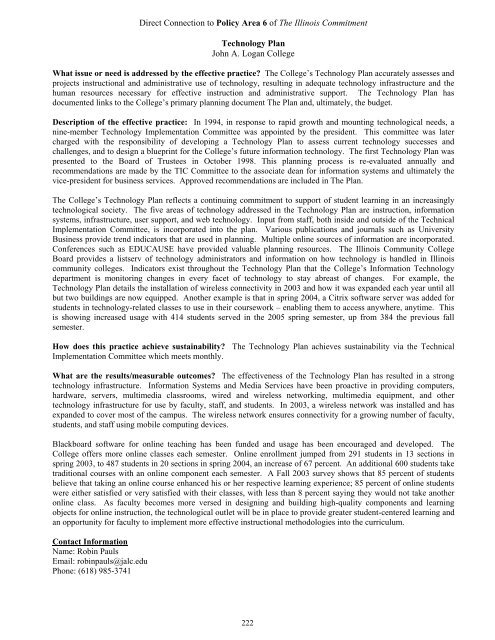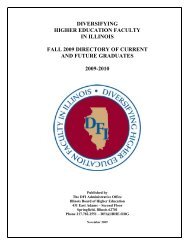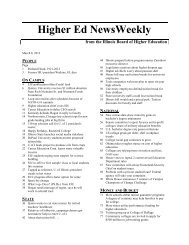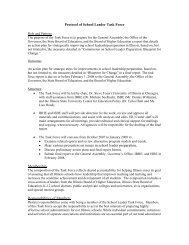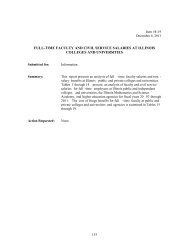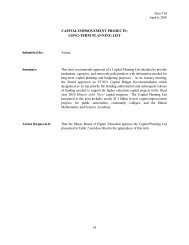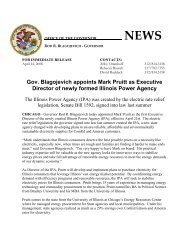Title of Effective Practice: - California Postsecondary Education ...
Title of Effective Practice: - California Postsecondary Education ...
Title of Effective Practice: - California Postsecondary Education ...
You also want an ePaper? Increase the reach of your titles
YUMPU automatically turns print PDFs into web optimized ePapers that Google loves.
Direct Connection to Policy Area 6 <strong>of</strong> The Illinois Commitment<br />
Technology Plan<br />
John A. Logan College<br />
What issue or need is addressed by the effective practice? The College’s Technology Plan accurately assesses and<br />
projects instructional and administrative use <strong>of</strong> technology, resulting in adequate technology infrastructure and the<br />
human resources necessary for effective instruction and administrative support. The Technology Plan has<br />
documented links to the College’s primary planning document The Plan and, ultimately, the budget.<br />
Description <strong>of</strong> the effective practice: In 1994, in response to rapid growth and mounting technological needs, a<br />
nine-member Technology Implementation Committee was appointed by the president. This committee was later<br />
charged with the responsibility <strong>of</strong> developing a Technology Plan to assess current technology successes and<br />
challenges, and to design a blueprint for the College’s future information technology. The first Technology Plan was<br />
presented to the Board <strong>of</strong> Trustees in October 1998. This planning process is re-evaluated annually and<br />
recommendations are made by the TIC Committee to the associate dean for information systems and ultimately the<br />
vice-president for business services. Approved recommendations are included in The Plan.<br />
The College’s Technology Plan reflects a continuing commitment to support <strong>of</strong> student learning in an increasingly<br />
technological society. The five areas <strong>of</strong> technology addressed in the Technology Plan are instruction, information<br />
systems, infrastructure, user support, and web technology. Input from staff, both inside and outside <strong>of</strong> the Technical<br />
Implementation Committee, is incorporated into the plan. Various publications and journals such as University<br />
Business provide trend indicators that are used in planning. Multiple online sources <strong>of</strong> information are incorporated.<br />
Conferences such as EDUCAUSE have provided valuable planning resources. The Illinois Community College<br />
Board provides a listserv <strong>of</strong> technology administrators and information on how technology is handled in Illinois<br />
community colleges. Indicators exist throughout the Technology Plan that the College’s Information Technology<br />
department is monitoring changes in every facet <strong>of</strong> technology to stay abreast <strong>of</strong> changes. For example, the<br />
Technology Plan details the installation <strong>of</strong> wireless connectivity in 2003 and how it was expanded each year until all<br />
but two buildings are now equipped. Another example is that in spring 2004, a Citrix s<strong>of</strong>tware server was added for<br />
students in technology-related classes to use in their coursework – enabling them to access anywhere, anytime. This<br />
is showing increased usage with 414 students served in the 2005 spring semester, up from 384 the previous fall<br />
semester.<br />
How does this practice achieve sustainability? The Technology Plan achieves sustainability via the Technical<br />
Implementation Committee which meets monthly.<br />
What are the results/measurable outcomes? The effectiveness <strong>of</strong> the Technology Plan has resulted in a strong<br />
technology infrastructure. Information Systems and Media Services have been proactive in providing computers,<br />
hardware, servers, multimedia classrooms, wired and wireless networking, multimedia equipment, and other<br />
technology infrastructure for use by faculty, staff, and students. In 2003, a wireless network was installed and has<br />
expanded to cover most <strong>of</strong> the campus. The wireless network ensures connectivity for a growing number <strong>of</strong> faculty,<br />
students, and staff using mobile computing devices.<br />
Blackboard s<strong>of</strong>tware for online teaching has been funded and usage has been encouraged and developed. The<br />
College <strong>of</strong>fers more online classes each semester. Online enrollment jumped from 291 students in 13 sections in<br />
spring 2003, to 487 students in 20 sections in spring 2004, an increase <strong>of</strong> 67 percent. An additional 600 students take<br />
traditional courses with an online component each semester. A Fall 2003 survey shows that 85 percent <strong>of</strong> students<br />
believe that taking an online course enhanced his or her respective learning experience; 85 percent <strong>of</strong> online students<br />
were either satisfied or very satisfied with their classes, with less than 8 percent saying they would not take another<br />
online class. As faculty becomes more versed in designing and building high-quality components and learning<br />
objects for online instruction, the technological outlet will be in place to provide greater student-centered learning and<br />
an opportunity for faculty to implement more effective instructional methodologies into the curriculum.<br />
Contact Information<br />
Name: Robin Pauls<br />
Email: robinpauls@jalc.edu<br />
Phone: (618) 985-3741<br />
222


